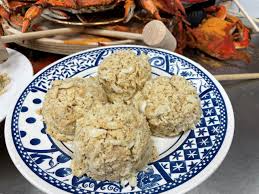Crab cakes are one of those culinary delights that instantly transport you to the seaside — the scent of salt air, the sound of waves crashing, and the promise of buttery, golden perfection on your plate. But what makes a crab cake truly the best? From the type of crab to the preparation method, every detail matters. Let’s dive deep into the art of creating (and enjoying) the ultimate crab cake.
🏝️ The Origins of the Crab Cake
The crab cake’s story begins along the eastern coast of the United States, particularly in Maryland, where the Chesapeake Bay has long been home to the famous blue crab cake . For generations, locals have perfected the balance between simple ingredients and fresh seafood flavor.
Early recipes were created out of necessity — fishermen and families used the crabs they caught daily, mixing the meat with breadcrumbs and eggs to create a hearty, satisfying meal. Over time, crab cakes evolved from a fisherman’s staple to a fine-dining delicacy found in restaurants across the world.
🦞 Choosing the Right Crab Meat
If there’s one secret to the perfect crab cake, it’s the crab itself. The type of meat you choose makes all the difference.
🦐 Lump vs. Backfin vs. Claw
- Jumbo Lump: The gold standard. These large, delicate chunks come from the crab’s swimming muscles, offering a sweet, succulent flavor and impressive texture.
- Backfin: A mix of lump and smaller flakes — still flavorful, but a bit more affordable.
- Claw Meat: Darker, stronger in flavor, and excellent if you want a more robust taste.
For truly the best crab cake, use fresh jumbo lump crab meat with minimal filler so that each bite bursts with pure crab flavor.
🍞 The Perfect Binder: Less Is More
The worst crime against crab cakes? Too much filler. The best versions are almost pure crab, held together just enough to stay intact during cooking.
Key Ingredients That Bind Without Overpowering
- Mayonnaise for creaminess and moisture
- Egg for structure
- A touch of breadcrumbs or crushed saltines for light binding
- Mustard (preferably Dijon) for a subtle tang
- Old Bay seasoning for that unmistakable Chesapeake flavor
The trick is to use these ingredients sparingly — you’re enhancing the crab, not masking it.
🌿 Seasonings & Flavor Boosters
A great crab cake doesn’t need a long list of spices. Simplicity allows the natural sweetness of the crab to shine.
Popular Flavor Add-Ons
- Old Bay Seasoning — the classic spice blend that screams Maryland
- Fresh parsley — for color and a hint of freshness
- Lemon zest or juice — brightens every bite
- Worcestershire sauce — adds depth and umami
- A pinch of cayenne — for those who like a little heat
Remember, the best crab cake strikes a perfect balance: savory, slightly tangy, with a hint of spice that complements, not competes with, the crab.
🔥 Cooking Method: Pan-Fried or Baked?
This debate has divided crab cake lovers for decades. Both methods have their merits — it depends on your preference for texture and richness.
🍳 Pan-Fried Crab Cakes
Pan-frying in butter or a light oil creates a crispy golden crust while keeping the inside tender and juicy. It’s the preferred method for many chefs because it delivers that classic crunch in every bite.
🔔 Baked Crab Cakes
For a lighter version, baking works wonders. The cakes stay moist, require less oil, and are easier to make in batches. Simply brush them with melted butter before baking for that signature golden hue.
Pro Tip: Chill your crab mixture for 30 minutes before cooking — this helps the cakes stay firm and prevents them from falling apart in the pan.
🥗 The Perfect Pairings
Even the best crab cake can be elevated by the right sides and sauces. The goal is to enhance its flavor without stealing the spotlight.
Classic Companions
- Tartar sauce — creamy, tangy, and timeless
- Lemon wedges — a bright squeeze brings balance
- Coleslaw — adds a crunchy, refreshing contrast
- Roasted corn or asparagus — seasonal and light
- Herbed aioli — a gourmet twist for extra flavor
If you’re serving crab cakes as a main course, consider pairing them with a crisp Chardonnay or a cold pilsner for the ultimate coastal experience.
🍽️ Presentation: Making It Look as Good as It Tastes
The best crab cakes deserve more than a paper plate. Serve them on a simple white dish to let their golden-brown beauty shine. Garnish with:
- A sprinkle of fresh herbs
- A drizzle of lemon butter sauce
- A side of microgreens for an elegant touch
Remember, we eat with our eyes first — presentation can turn a homemade crab cake into a restaurant-quality masterpiece.
🌊 Pro Tips for Crab Cake Success
- Handle gently – Overmixing breaks the delicate crab lumps.
- Use fresh crab – The fresher the crab, the better the flavor.
- Chill before cooking – Helps them hold shape.
- Taste test your mix – Cook a small spoonful first to adjust seasoning.
- Don’t rush – Let the cakes cook slowly over medium heat to ensure even browning.
These small touches make all the difference between “pretty good” and unforgettable.
🏆 Final Bite: Why Simplicity Wins
The best crab cake isn’t overloaded with breadcrumbs or hidden under spicy sauces. It celebrates the natural sweetness of the crab, enhanced by subtle seasoning, crispy edges, and just enough binder to hold it together.
In a world full of over-complicated dishes, the humble crab cake reminds us that fresh ingredients, light hands, and respect for tradition can produce something truly extraordinary.
So next time you crave the taste of the ocean, skip the fancy fusion dishes and go back to basics — the golden, buttery, melt-in-your-mouth best crab cake that captures the very essence of coastal cuisine.





Comments